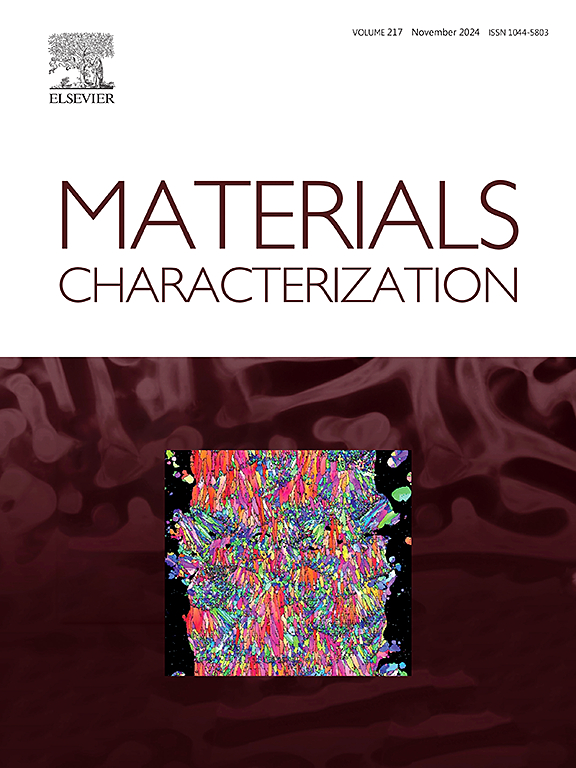Microstructure refinement, thermal stability and mechanical properties improvements of Sn-3.0Ag-0.5Cu-xSb
IF 5.5
2区 材料科学
Q1 MATERIALS SCIENCE, CHARACTERIZATION & TESTING
引用次数: 0
Abstract
This study systematically elucidates the effects of antimony (Sb) additions (0, 0.5, and 1.5 wt%) on the microstructure, thermal stability, wettability, and mechanical performance of SAC305 solder alloys at both bulk and solder joints. The results demonstrate that incorporating 1.5 wt% Sb leads to significant microstructure refinement as evidenced by a 66 % reduction in crystallite sizes of β-Sn phase through Synchrotron X-ray Diffraction. Synchrotron micro-XRF mapping analysis further confirmed a uniform distribution of Sb within the matrix phase, which contributes to enhanced grain refinement. Additionally, Sb addition reduces the interfacial intermetallic compound (IMC) layer thickness by 9 %, enhancing joint reliability. The undercooling values were also reduced with increasing Sb content, indicating improved thermal stability. The growth restriction factor (Q) was calculated, and the results demonstrated that the Q value increased from 13.82 to 15.62 with 1.5 wt% Sb addition highlighting Sb’s role as an effective grain refiner. Mechanical testing confirmed that Sb additions enhance the mechanical performance of both bulk solder and solder joints primarily through solid solution strengthening mechanisms. By employing advanced synchrotron-based characterization techniques to quantitatively correlate Sb-induced microstructure refinement with improved mechanical and thermal properties, these findings contribute to a deeper understanding that is crucial for optimizing reliability in electronic packaging systems while providing new insights into the role of Sb in optimizing the performance and reliability of SAC305 solder alloys.
Sn-3.0Ag-0.5Cu-xSb的组织细化、热稳定性和力学性能改善
本研究系统地阐明了锑(Sb)添加量(0、0.5和1.5 wt%)对SAC305钎料合金在大块和焊点处的微观结构、热稳定性、润湿性和机械性能的影响。结果表明,加入1.5 wt%的Sb后,通过同步加速器x射线衍射,β-Sn相的晶粒尺寸减小了66%,从而导致了显著的微观结构细化。同步加速器微xrf图谱分析进一步证实Sb在基体相内均匀分布,有利于晶粒细化。此外,添加Sb可使界面金属间化合物(IMC)层厚度降低9%,提高了接头的可靠性。过冷值也随着Sb含量的增加而降低,表明热稳定性得到改善。计算了生长限制因子(Q),结果表明,添加1.5 wt% Sb时,Q值从13.82增加到15.62,突出了Sb作为有效晶粒细化剂的作用。力学试验证实,添加Sb主要是通过固溶体强化机制来提高钎料和焊点的力学性能。通过采用先进的基于同步加速器的表征技术,定量地将Sb诱导的微观结构细化与改善的机械和热性能联系起来,这些发现有助于更深入地了解电子封装系统的可靠性优化,同时为Sb在优化SAC305焊料合金的性能和可靠性方面的作用提供了新的见解。
本文章由计算机程序翻译,如有差异,请以英文原文为准。
求助全文
约1分钟内获得全文
求助全文
来源期刊

Materials Characterization
工程技术-材料科学:表征与测试
CiteScore
7.60
自引率
8.50%
发文量
746
审稿时长
36 days
期刊介绍:
Materials Characterization features original articles and state-of-the-art reviews on theoretical and practical aspects of the structure and behaviour of materials.
The Journal focuses on all characterization techniques, including all forms of microscopy (light, electron, acoustic, etc.,) and analysis (especially microanalysis and surface analytical techniques). Developments in both this wide range of techniques and their application to the quantification of the microstructure of materials are essential facets of the Journal.
The Journal provides the Materials Scientist/Engineer with up-to-date information on many types of materials with an underlying theme of explaining the behavior of materials using novel approaches. Materials covered by the journal include:
Metals & Alloys
Ceramics
Nanomaterials
Biomedical materials
Optical materials
Composites
Natural Materials.
 求助内容:
求助内容: 应助结果提醒方式:
应助结果提醒方式:


